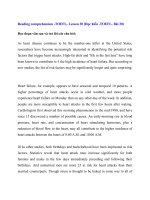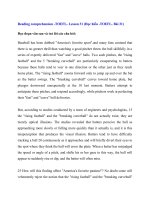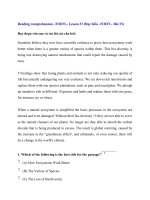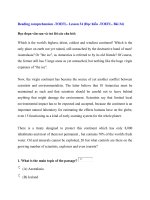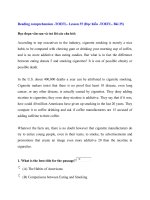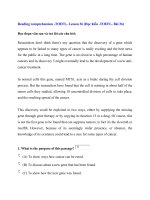Đọc hiểu -TOEFL- Bài 9 potx
Bạn đang xem bản rút gọn của tài liệu. Xem và tải ngay bản đầy đủ của tài liệu tại đây (76.28 KB, 7 trang )
Reading comprehension -TOEFL- Lesson 9 (Đọc hiểu -TOEFL- Bài 9)
Đọc đoạn văn sau và trả lời các câu hỏi:
A balanced diet contains proteins, which are composed of complex amino acids.
There are 20 types of amino acids, comprising about 16 percent of the body weight
in a lean individual. A body needs all 20 to be healthy. Amino acids can be divided
into two groups: essential 5 and nonessential. There are 9 essential amino acids.
These are the proteins that the body cannot produce by itself, so a healthy
individual must ingest them. The 11 nonessential amino acids, on the other hand,
are produced by the body, so it is not necessary to ingest them. Proteins are
described as being either high-quality or low-quality, 10 depending on how many
of the 9 essential amino acids the food contains. High-quality proteins, typically
found in animal meats, are proteins that have ample amounts of the essential amino
acids. Low-quality proteins are mainly plant proteins and usually lack one or more
of the essential amino acids. Since people who follow a strict vegetarian 15 diet are
ingesting only low-quality proteins, they must make sure that their diets contain a
variety of proteins, in order to ensure that what is lacking in one food is available
in another. This process of selecting a variety of the essential proteins is called
protein complementation. Since an insufficient amount of protein in the 20 diet can
be crippling, and prolonged absence of proteins can cause death, it is imperative
that a vegetarian diet contains an ample amount of the essential proteins.
1. With what topic is this passage primarily concerned?
(A) the 20 types of amino acids
D
(B) high- and low-quality proteins
(C) the process of complementation
(D) healthy diets for vegetarians
2. The word "lean" in line 3 could be best replaced by
(A) thin
(B) fat
(C) tall
(D) short
3. The word "ingest" in line 7 is closest in meaning to which of the following?
(A) chew
(B) swallow
A
(C) suck
(D) drink
4. The word "ample" in line 13 is closest in meaning to which of the following?
(A) meager
(B) frequent
(C) substantial
(D) harmful
5. Which of the following would NOT be an example of a low-quality protein?
(A) legumes
(B) apples
C
D
(C) grains
(D) tuna
6. As used in line 14, which of the following words is closest in meaning to
"strict"?
(A) responsible
(B) casual
(C) harmonious
(D) rigid
7. According to the passage, a vegetarian could die from insufficient protein
ingestion if he or she
(A) did not follow a varied and properly protein-complemented diet.
D
A
(B) ate too many animal proteins,and could not digest them properly.
(C) did not follow a diet in which nonessential proteins were ingested.
(D) ate too many low-quality proteins.
8. Which of the following is closest in meaning to the word "crippling" as used
in line 20?
(A) discouraging
(B) betraying
(C) incapacitating
(D) amazing
9. Which of the following words could best replace the word "prolonged" in
line 20?
C
D
(A) narrow
(B) hollow
(C) hard-hearted
(D) extended
10. In line 21, the word "imperative" can be best replaced by
(A) crucial
(B) impossible
(C) wonderful
(D) satisfying
11. Which of the following best describes the author's tone in this passage?
A
A
(A) forceful
(B) light
(C) casual
(D) argumentative
12. Which statement best describes the organization of this passage?
(A) Contrasting views concerning proteins are compared.
(B) The author moves from a general comment to a specific argument.
(C) A statement is given and its cause is then discussed.
(D) Items are discussed in their order of importance.
B



